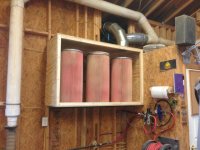I am upgrading my CV1800 by moving it to the second floor where I can build a closet around it to reduce the noise. I have a question about the side by side filter plenum. How should I build my new plenum? So far I have seen 2 variations, and I am unsure which one will be better. The first variation has 2 circular pieces ( w/ 8" holes) with a smaller box box on top attaching the 2. The second variation is a 16" x 32.5" box w/ the 8" holes. Should the edges of whatever box I make be at the edge of the filter inlet so that if there is any dust in the plenum it will fall down into the filter, or is this unnecessary? Also, should I build up the inside of the square top of the Wynn filter so that when I screw into it it will seal and not indent? (Last time( when I installed one on top of the other, I removed the rubber gasket applied there and applied it to the bottom- should I just leave the rubber gasket there by the square metal lip and screw into the plenum through that square metal lip?)
My system is presently mounted on steel I beams that cause a loud hum when it is working which unnerves me. I plan on mounting it to a cement wall. Any suggestions on how to reduce noise from the wall mount? (It will now be above the steel I beams, and part of the cyclone will go through the floor ( 3/4 " ply) which will be applied to the I beams. I am assuming that having about 1/3 of the cyclone visible will not add to the noise. Is this an incorrect assumption? I plan to close off the motor and side by side filter in a closet. Do I need to insulate the wall side as well? (It will placed in a corner where one side is cinder block and the other concrete).
I also saw a post where someone used tennis balls to reduce noise on the motor mount, but I am unclear on how to do that or if it will be necessary given that I am mounting to a concrete wall at the back of my shop.
Any input is welcome. Thanks in advance.
AG
My system is presently mounted on steel I beams that cause a loud hum when it is working which unnerves me. I plan on mounting it to a cement wall. Any suggestions on how to reduce noise from the wall mount? (It will now be above the steel I beams, and part of the cyclone will go through the floor ( 3/4 " ply) which will be applied to the I beams. I am assuming that having about 1/3 of the cyclone visible will not add to the noise. Is this an incorrect assumption? I plan to close off the motor and side by side filter in a closet. Do I need to insulate the wall side as well? (It will placed in a corner where one side is cinder block and the other concrete).
I also saw a post where someone used tennis balls to reduce noise on the motor mount, but I am unclear on how to do that or if it will be necessary given that I am mounting to a concrete wall at the back of my shop.
Any input is welcome. Thanks in advance.
AG


